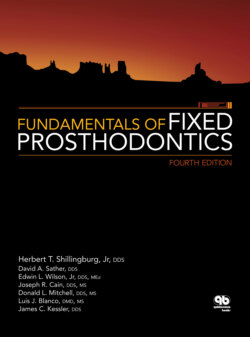Читать книгу Fundamentals of Fixed Prosthodontics - James C. Kessler - Страница 11
На сайте Литреса книга снята с продажи.
Terminology
ОглавлениеA crown is a cemented or permanently affixed extracoronal restoration that covers, or veneers, the outer surface of the clinical crown. It should reproduce the morphology and contours of the damaged coronal portions of a tooth while performing its function. It should also protect the remaining tooth structure from further damage.
If it covers the entire clinical crown, the restoration is called a full veneer, full coverage, complete, or just a full crown (Fig 1-1). It may be fabricated entirely of a gold alloy or another untarnishable metal, a ceramic veneer fused to metal, an all-ceramic material, resin and metal, or resin only. If only portions of the clinical crown are veneered, the restoration is called a partial coverage or partial veneer crown (Fig 1-2).
Intracoronal restorations are those that fit within the anatomical contours of the clinical crown of a tooth. Inlays may be used as single-tooth restorations for Class II proximo-occlusal or Class V gingival lesions with minimal to moderate extensions. They may be made of gold alloy (Fig 1-3a), a ceramic material (Fig 1-3b), or processed resin. When modified with occlusal coverage, the intracoronal restoration is called an onlay and is useful for restoring more extensively damaged posterior teeth needing wide mesio-occlusodistal (MOD) restorations (Fig 1-4).
Another type of cemented restoration that has gained considerable popularity in recent years is the all-ceramic laminate veneer, or facial veneer (Fig 1-5). It is used on anterior teeth that require improved esthetics but are otherwise sound. It consists of a thin layer of dental porcelain or cast ceramic that is bonded to the facial surface of the tooth with an appropriate resin.
The fixed partial denture is a prosthetic appliance that is permanently attached to remaining teeth or implants and replaces one or more missing teeth (Fig 1-6). In years past, this type of prosthesis was known as a bridge, a term that has fallen from favor1,2 and is no longer used.
A tooth or implant serving as an attachment for a fixed partial denture is called an abutment. The artificial tooth suspended from the abutments is a pontic. The pontic is connected to the fixed partial denture retainers, which are extracoronal restorations that are cemented to or otherwise attached to the abutment teeth or implants. Intracoronal restorations lack the necessary retention and resistance to be used as fixed partial denture retainers. The connectors between the pontic and the retainer may be rigid (ie, solder joints or cast connectors) or nonrigid (ie, precision attachments or stress breakers) if the abutments are teeth. As a rule, only rigid connectors are used with implant abutments.
